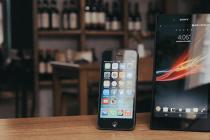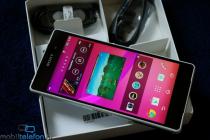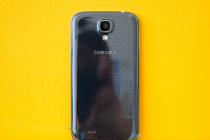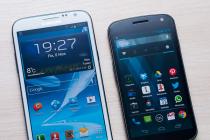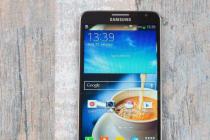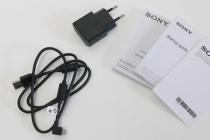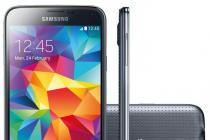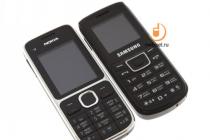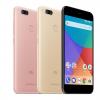Samsung decided this year that size really matters, so new Galaxy The S8 and Galaxy S8 + get larger screens at 5.8 and 6.2 inches, respectively. Other companies have already tried to make devices with the maximum large displays, but the Koreans in this regard have really reached a new, unprecedented level. How convenient it is to use the new "galaxies" - read the translation of the review from YugaTech on Treshbox.
It is noteworthy that even the simple version of the Galaxy S8 has a diagonal screen larger than that of the unsuccessful Galaxy Note 7 phablet, not to mention the "plus". What then will the eighth Galaxy Note be? Will his screen be bigger than 6.2 inches? It's very interesting what Samsung will come up with for fans of a stylus and a large display, but for now let's look at the eighth "galaxy".
Specifications
- Screen: 5.8 / 6.2 inches, Super AMOLED, 2960 × 1440 pixels, 570/529 ppi, Corning Gorilla Glass 5 protective glass.
- Operating system: Android 7.1 Nougat, Samsung Experience 8.1 shell.
- Processor: Exynos 8895, eight-core (4 × Cortex-A53 at 1.7 GHz and 4 × 2.3 GHz at 2.3 GHz), 10 nm.
- GPU: Mali G71-MP20.
- RAM: 4 GB (LPDDR4).
- Storage: 64 GB (UFS 2.1) with support for microSD cards up to 256 GB.
- Main camera: 12 megapixels (Sony IMX333 + S5K2L2 ISOCELL), Dual Pixel, aperture f / 1.7, optical stabilization (OIS), video recording 1080p × 60FPS, 4K × 30FPS.
- Front camera: 8 megapixels, wide-angle sensor, f / 1.7 aperture.
- Battery: 3000/3500 mAh, lithium-ion, fast charging from 0 to 100% in 75 minutes.
- Dimensions (mm): 148.9 x 68.1 x 8.0 (Galaxy S8), 159.5 x 73.4 x 8.1 (Galaxy S8 +).
- Weight (gram): 155/173.
- Slots for SIM-cards: one nanoSIM, the second is combined.
- Communication: 4G / LTE (up to category 16), Bluetooth 5.0, USB Type-C, 3.5 mm audio jack, dual-band (2.4 / 5 GHz) Wi-Fi 802.11 a / b / g / n / ac, GPS / GLONASS / Galileo.
- Sensors: Fingerprint scanner, pressure sensor, accelerometer, barometer, gyroscope, geomagnetic sensor, Hall sensor, heart rate sensor, proximity sensor, light sensor.
- Water protection: IP68.
- Available colors: in Russia so far only black, golden and mystical (pink-gray).
- Price: 54,990 / 59,990 rubles.
Appearance and design
The flagship Galaxy S line has undergone a big redesign this year. The general concept has not changed, but the approach is completely different. Both versions of the smartphone received a curved screen on the edges, and the bezels were greatly reduced at the top and bottom. As with the LG G6, the corners of the display panel are rounded. It is not only beautiful, but also practical in terms of the strength of the case. When dropped or others external influences less chance of damage to the matrix with rounded corners.

The hardware control buttons and the Samsung logo, which used to be usually located on the top frame, were removed from the front panel. This freed up space for the display. Only a few sensors remain and front-camera... We have already seen this in Xiaomi Mi MIX, which on the front side of the case has nothing but a display, a camera and a pair of sensors.



The bottom edge is strewn with a 3.5 mm port, universal USB Type-C and speaker mesh. Sadly, Samsung hasn't dabbled in two separate stereo speakers just yet.

The top edge is equipped with a tray for nanoSIM cards. There's also an optional hybrid microSD card slot up to 256GB. It can be used for optional nanoSIM.

The rear panel contains a camera sensor that does not protrude from the body with a two-tone LED flash on the left and a fingerprint scanner on the right. The position of the fingerprint sensor is at least strange, but more on that later. The back of the device is covered with a protective glass Corning Gorilla Glass 5... It is slightly curved along the edges, which creates a pleasant visual effect, but also thanks to this, the phone fits perfectly in the hand.

Preserved protection of the case from water and dust according to the standard IP68... The smartphone can be immersed in water to a depth of 1.5 meters for no more than 30 minutes.
Overall, there are no questions for Samsung in terms of the look and feel of the Galaxy S8. The phone looks impressive and fits nicely in the hand.
Screen

Samsung is doing the right thing by making the screen the main feature of its smartphones. They are allowed to do this, because their own panels Super AMOLED- almost the best on the market. Galaxy S8 has the most big screen in the flagship line South Korean manufacturer... 5.8 "is even more than the typical diagonal of a phablet (5.5-5.7"). This is a big improvement, especially considering the dimensions that are almost identical to the previous generation.

Such a diagonal was achieved by removing the hardware buttons and the fingerprint scanner on the rear panel. The Samsung inscription was also moved there. The frames have been reduced to a minimum - there is only room left for the front camera, a pair of sensors and an iris scanner.

The edges of the display are curved, as you would expect from a smartphone from Samsung's flagship line. Recall that this "feature" first appeared in the Galaxy Note edge, and then migrated to Galaxy line S. Now there is no division into regular and edge-versions - both "galaxies" have a curved screen.
Screen resolution - 2960 × 1440 pixels(WQHD +). Thus, the pixel density is 570 dpi. Smartphone firmware has a function that automatically or manually changes the screen resolution to save energy. By default, the indicator is set to Full HD + (2280 × 1080). The lowest bar is HD + (1480 × 720). The latter is used when the power saving mode is on.

From left to right: resolution selection, picture mode and other settings
The aspect ratio of such a screen is rather strange - 18.5: 9. Not the best option for watching videos and pictures in games. But the firmware provides a function for adapting content to the display.
As for the matrix itself, these are top-end Super AMOLED panels of high quality. Color rendition, detail and contrast are at a high level. The display behaves beautifully under the rays of the sun - readability remains. V Galaxy firmware The S8 has a feature to reduce blue radiation at night - reduces eye strain.
Camera

Samsung pays a lot of attention to the camera in its flagship smartphones. The eighth generation of the "galaxy" was no exception - the devices perfectly capture both photos and videos. Galaxy S8 uses new Sony IMX333 sensor and S5K2L2 ISOCELL sensor with resolution 12 megapixels(the same was in S7).









Sample photos from Galaxy S8 (images are highly compressed)
The main camera supports optical image stabilization (OIS)... The videos are very high quality, but it is clear that Samsung programmers have not yet completed software cameras. With sharp turns, the picture is slightly blurred. Perhaps this will be fixed with the final update before the start of sales. Supports video recording in 4K × 30FPS or 1080p × 60FPS resolution. The frame rate for slow motion video is capped at 240FPS at 720p resolution.
The front camera has received a big improvement - from 5 to 8 megapixels. There is a wide-angle sensor with a good aperture index - f / 1.7. Your selfies will definitely look good even in poor lighting conditions.

The camera app interface has been heavily redesigned. Now he looks like some kind social network like Snapchat. We've added a lot of interesting functions and tricks. For knowledgeable users, there is a professional shooting mode. It allows you to manually adjust the ISO (50-800), shutter speed (1/2400 to 10 seconds), white balance and picture profile.
In the Galaxy S7, a lot of people liked the double-tap on the Home button to launch the camera. Since it was removed, this "feature" moved to the unlock button.
Operating system

New items work on the Android 7.0 Nougat platform, on top of which the proprietary firmware is installed Samsung Experience(formerly TouchWiz). As is always the case with Samsung, several applications are preinstalled: Samsung Notes, branded Browser, Secure Folder, and others. Still, it's not as bad as it was in the 2014-2015 versions of TouchWiz.

Since the hardware control buttons were removed, Samsung decided to slightly neutralize this loss. Now almost always there are below virtual buttons Recent, Home and Back. Sometimes two disappear, but only Home remains. The center button has a pleasant feedback and customizable sensitivity. On the desktop, there is no separate button for calling the application menu - a universal gesture from bottom to top or vice versa is responsible for this.

There is special software for curved screen edges: App Edge, People Edge, Clipboard Edge and more. All of this interacts in one way or another with the curved screen. For example, you can bring up the favorites bar by swiping over this area. There is also a utility for creating a screenshot or even a GIF animation.

Security features include a fingerprint sensor and an iris scanner. The finger sensor was moved to back cover and placed next to the camera. Thus, you can reach it with a normal grip only with your right hand and index finger. But also the fingers themselves should be long enough. The sensor itself is fast and stores up to four fingerprints.


Another innovation in the firmware and design of the smartphone is the Bixby voice assistant. It can be called up in any application using the button on the left side of the case. Bixby is a mixture of a traditional voice assistant, trained artificial intelligence and a recommendation system. Wherever you call Bixby, it will understand the context and find exactly what you need. However, the assistant practically does not work in the test samples.
Overall, Samsung's new Android skin is very enjoyable to work with. Smooth animations and cute icons are pleasing to the eye, and thoughtful functions make the usual interaction with a smartphone a real pleasure. For those who do not like the standard interface, themes are available in the corporate directory - there you can find a shell to your liking.
The 64 GB test sample was free 53.98 GB... Thus, more than 10 GB is occupied by the firmware.
Iron

On the test, the guys from YugaTech.com got a smartphone in a version with a processor Exynos 8895 own production of Samsung. It is with this chipset that the Galaxy S8 for Europe and the CIS is equipped. This is the ninth generation of Exynos processors. And they can compete with solutions from Qualcomm, Huawei and other companies.
Exynos 8895 is built on a 4 + 4 architecture: four ARM Cortex-A53 cores (1.7 GHz) are responsible for simple tasks, and four custom Exynos M1 cores (2.3 GHz) are included when processing heavy processes like games. But the main difference between the 8895 and the previous generation is the graphics accelerator. The novelty uses the Mali G71-MP20 video chip. The big increase in productivity is precisely his merit.
Even though Samsung has ditched the new Cortex-A73 cores (Snapdragon 835 and Kirin 960), the Exynos M1's own cores show roughly the same power.
Test results Galaxy S8 in benchmarks:
- AnTuTu: 174 155.
- Quadrant Standard: 43 185.
- PCMark: 5,371 (Work 2.0), 6,034 (Work 1.0).
- PCMark Storage: 4,421.
- 3DMark: 3,159.
- Vellamo: 7,269 (Browser), 3,324 (Graphics Metal), 3,621 (multi-core test).
- Geekbench 4.0: 1,974 (single-core), 6,339 (multi-core).
Calls, connectivity and battery

New Samsung flagship equipped with all modern communication standards, including 4G / LTE, dual-band Wi-Fi, Bluetooth 5.0(for the first time in a smartphone) and NFC. Voice quality in calls is perfect. It's nice that Samsung still puts a lot of emphasis on the most important phone function - making calls. Bluetooth receiver The fifth version allows you to connect two pairs of headphones or other audio accessories to one Galaxy S8.
Having increased the diagonal of the screen, Samsung, unfortunately, decided not to do the same with the battery. An ordinary "galaxy" has a non-removable battery with a capacity 3,000 mAh, and in the Plus version - 3,500 mAh... However, the manufacturer claims that the runtime will remain the same.

In the benchmark PC Mark Battery Test, which emulates an intense load, the smartphone lasted 10 hours and 43 minutes. At the same time, the brightness was set to 50%, the sound was turned off, and the phone was also switched to airplane mode. To be honest, the result is controversial. The same Galaxy S7 worked longer in the same benchmark.
Galaxy S8 in mode video playback lasted 10 hours 45 minutes at the same brightness, volume and switched off networks. And this is also less than in the Galaxy S7 - by about 1 hour.

Stand for wireless charging Galaxy S8
As they say, here you can decide for yourself what is more important for you - a cool and large screen, or a little longer battery life. The battery is charged via the USB Type-C connector in about 75 minutes from 0 to 100%. Supported wireless charger... And yes - it doesn't explode when charged.
Outcomes
Samsung has tried to do really new smartphone original and innovative. Although we have already seen the LG G6 and Xiaomi Mi MIX, the eighth galaxy is a completely different smartphone. Koreans have come close to the point where we will just carry a large panel with a display without bezels and a bulky body.
In the Galaxy S8, you can find the best screen, powerful processor, great body design, quality materials and a good camera.
Of course, art requires sacrifice, so there was a fly in the ointment in a barrel of honey. The disadvantages include poor ergonomics of the fingerprint scanner. In addition, the price has increased, although for Russia this is not particularly noticeable - the price tags for the new Galaxy S8 are approximately at the same level as that of the Galaxy S7 at the start of sales.
Good:
- Stylish design.
- Great screen.
- Powerful processor and a lot of memory.
- Good camera.
- Iris scanner.
- A well-developed shell for Android.
- Opening times could have been better.
- The price has gone up.
- The fingerprint scanner is inconvenient.
Samsung Galaxy The S8 is one of the most anticipated flagships of 2017, so we decided not to delay reviewing it. The demand for the new model turned out to be simply colossal, people lined up in huge queues and rushed to pre-order in order to be among the first to get the first smartphone on the Snapdragon 835 chip and with an iris scanner. The company tried to offer a truly innovative, and most importantly, reliable product in order to regain its reputation after the self-igniting Note 7. Let's review the Samsung Galaxy S8 smartphone to see how successful the flagship turned out this time.
Samsung Galaxy S8 package contents
The package bundle turned out to be quite rich, because Samsung is one of the few manufacturers who continues to accompany their devices with a high-quality headset developed together with AKG. Also inside the box we will find a compact charger, a USB Type-C cable, an adapter for microUSB and USB-A, as well as documents and a paper clip for easily removing the SIM card tray.
Design
We will look at the Samsung Galaxy S8 a little later, but now let's focus on its appearance. New model inherited the basic design lines of the S7 edge and Note 7. The manufacturer decided to abandon the wide bezels around the display, which puts the S8 on a level above most of the competitors. The company managed the impossible in a compact case: 148.9x68.1 mm fit a large 5.8-inch display.
Thanks to a new approach, it occupies 84.26% of the front panel of the device. In this regard, the company called its screen “endless”. Its side ends are slightly bent, which makes it feel like you are holding only one display in your hands. The Samsung Galaxy S8 smartphone turned out to be truly innovative, because the manufacturer did not limit itself to one frame. Through the efforts of the world's leading experts, it was possible to develop an impressive design. All elements are made in the same style, and the rounded corners and edges perfectly complement the look. The corners of the screen are rounded to fit the shape of the case. The corporate logo will no longer flaunt on the front side, because the smartphone is already recognizable.

The new Samsung Galaxy S8 64gb from the back is not so expressive, but there is also a recognizable style and symmetry here. The camera module from now on does not protrude beyond the body, and on the sides of it are LED backlighting, a heart rate sensor and a fingerprint scanner. The latter is not very conveniently located. In an attempt to find it, you can touch the camera lens.

The back and front panels are covered with Gorilla Glass 5, and the ends are made of metal to give rigidity to the case. They are now polished and painted to match the overall body color to complement the design. Due to this, the impression is formed that the device consists entirely of glass.

The Samsung Galaxy S8 g955f black looks especially pretty, but there is also arctic silver, coral blue, orchid gray, and maple gold. The use of premium materials contributes to a better perception of the flagship and pleasant sensations in the process of use, but unfortunately glass is still the most easily soiled material that quickly collects fingerprints. Samsung Galaxy S8 review in Russian showed that the case does not play, no matter how hard you put pressure on it. At the same time, it is better to wear it in a protective bumper, since glass is much inferior in strength to metal.
Galaxy S8 received a larger display than S7 edge, but the dimensions of the case, on the contrary, have decreased. Thanks to the rounded ends, the body fits like a glove in the hand, the smartphone is comfortable to use even with one hand. The sides of the display are not curved as much as in the S7 edge, thus avoiding accidental clicks.
The changes also affected the controls. Now the function keys have become virtual, although they are convenient to use. The Home key senses pressure and vibrates to confirm every action, so it can be easily groped blindly shortly after purchasing. In the settings, you can set your own location of the control keys.
The body is equipped with protection against water and dust according to the modern IP68 standard. This means that it can be lowered to a depth of 1 meter under water and up to 30 minutes.




Galaxy S8 display
The Samsung Galaxy S8 screen is the first thing that catches your eye. It occupies most of the front surface, and its diagonal is 5.8 inches. As before, the manufacturer uses a Super AMOLED matrix in its technology, but this time the resolution turned out to be non-standard - 2960 × 1440 pixels with an innovative aspect ratio of 18.5: 9. In this regard, the display of the Samsung Galaxy S8 turned out to be smaller in width but larger in height compared to the classic models, which have an aspect ratio of 16: 9. The main achievement of the company is that it managed to fit a larger display into a body, smaller than that of the S7 edge (5.8 versus 5.5 inches).
Samsung Galaxy S8 64gb smartphone review showed that non-standard resolution practically did not affect the application interface. They successfully adapt to it in most cases. In addition, you will always have a choice: use the program in its standard aspect ratio, or stretch it to fill the entire display. The multitasking menu has a separate key to control the aspect ratio. In games, everything is a little more difficult. Sometimes the keys eat up the edges of the screen, but this is not critical. It is not at all necessary to stretch the game over the entire display, because the black stripes along the ends do not attract much attention. The same applies to videos that are shot predominantly in a 16: 9 aspect ratio.

Samsung Galaxy S8 review in Russian showed that the viewing angles and color reproduction are amazing. In the parameters, you can select the mode of forming colors, making them more saturated or realistic. Our testing showed excellent factory calibration with a warm bias, virtually perfect gamut and even backlighting. If desired, you can activate the "Blue Filter" in the menu.
Another feature is the ability to select the display resolution - HD (1480 × 720), FullHD (2220 × 1080) or WQHD (2960 × 1440). If you set the maximum resolution, the pixel density per inch will be 570, which is more than enough. There is no question of any pixel grid, it is impossible to see it. It's not even in HD. It should be noted that lowering the resolution greatly increases the autonomy, which is associated with a reduced load on the processor. FullHD can be called optimal, higher resolution is required except for VR glasses.

Samsung Galaxy S8 2017 review reveals what has survived interesting function display on the locked display of certain information that the user selects. It was possible to implement it due to the fact that in AMOLED panels, each pixel is highlighted separately. The function has been slightly improved. So, now the display completely dies out when the Samsung Galaxy S8 smartphone is in your pocket, which saves battery power. The brightness level is selected automatically depending on the current illumination level. A detailed review of the Samsung Galaxy S8 showed that the Edge option was not without. With its help, you can display a curtain on the edge of the screen, with which you can access various applications and functions.

The Galaxy S8 introduces a speed dial panel, which includes four tools that allow you to crop an area of the screen, recognize text from a picture, make a GIF from a piece of video and select an area of the display, and then fix it on top of other programs.
Samsung Galaxy S8 performance
The full Samsung Galaxy S8 review moves on to the specs. Let's start with the fact that this model is the first to use 5th generation Bluetooth, which provides not only more high speed data transmission, but also the ability to simultaneously work with two BT-devices (for example, headphones and smart watches).
Samsung Galaxy S8 specifications include a powerful Exynos 8895 chip, developed by the efforts of Samsung specialists. It is built on a 10 nm process technology and is based on 4 Cortex A53 cores with a frequency of 1.7 GHz and 4 cores with a frequency of up to 2.35 GHz, developed in-house. In the form of a video accelerator, the Mali-G71 MP20 is involved, which is 40% more efficient than the Mali T880MP12 installed in the S7 edge.
The Samsung Galaxy S8 features 4GB of RAM and 64GB of user storage. There is a hybrid tray for a memory card, but when using it, you will have to abandon one nanoSIM. Performance on the highest level m, which is noticeable both when working with the interface and in resource-intensive applications. There is no dependence on permission, the device always flies. Based on the results of synthetic Galaxy tests The S8 has shown phenomenal results, becoming one of the most productive flagships to date.


Fingerprint and iris scanner
Specifications Samsung phone The Galaxy S8 is great - it's the first device to feature an iris scanner. But this function is still imperfect and needs to be improved. It is easy to fool it by substituting a photograph of the owner of the device under the lens of the front camera. It is safer to use a traditional fingerprint scanner, which cannot be swiped. By the way, it is located to the right of the camera lens, which is rather unusual and extremely inconvenient. A finger spontaneously falls on the camera and stains its lens while you fumble for the scanner.
Initially, the manufacturer planned to use the Synaptics technology, in which the scan is embedded under the display glass, but there was not enough time for its implementation. This is a complex technology that will definitely appear in the future devices of the manufacturer. It would be more logical to place the scanner under the camera, but over time you start to get used to the unusual location of the sensor. The scanner works lightning fast and reads touches from any angle. Samsung Galaxy S8 photo price specifications will be discussed in detail in our article.
The iris scanner is installed on the face of the device next to the camera. Fortunately, it is infrared, so it works well even in absolute darkness. The speed and quality of recognition is top notch, but it can fail in the bright sun. If you wear sunglasses, the recognition quality depends on the environment. Glare on glass can interfere normal work scanner, and if they are absent, then it works well through glasses.
Interface
Samsung Galaxy S8 user reviews speak positively about its shell and stability of operation. The interface is built on Android 7.0 with minor proprietary improvements in the form of the Samsung Experience shell. The company has done an excellent job of optimizing the OS for its own platform, and the interface logic has remained virtually unchanged compared to pure Android. Samsung Galaxy S8 mobile review revealed that the icons, notification shade and system apps were redrawn by the company's designers. The interface has become visually simpler and more pleasant to use. The animation works smoothly, even the slightest slowdowns are not noticed. To access the menu, you no longer need to look for a separate key, now all you need to do is perform a gesture from top to bottom on the desktop.
Samsung Galaxy S8 g950 review showed that during the initial setup, you can choose which applications from the manufacturer to install and which ones you decide to abandon. The Briefing panel, which was previously a news aggregator and hosted on one of the desktops, is now being replaced by Bixby. It was built into it as a widget. There is a separate mechanical key to launch the virtual assistant, so it can be removed from the desktop.

Bixby virtual assistant
The Samsung Galaxy S8 64gb smartphone has received a new virtual assistant. The essence of the idea is that developers can independently add to it own programs and services. And he, in turn, provides the user with a convenient system voice control... at the time of the announcement, Bixby already supported 50 apps. The assistant will analyze the user's preferences and display data that will be really interesting for him. There will also be new gadgets that make it easier to use the gadget and add new options. This is an interesting idea, which will definitely be developed.

Samsung Galaxy S8 camera review
Samsung Galaxy S8 mobile 128gb review moves to photographic capabilities. the resolution of the main module is 12 megapixels with an aperture of f / 1.7, optical and digital stabilization, a six-element lens and a sensor with a large 1.4μm pixel size. In terms of technical characteristics, the camera module has not changed since the S7 edge, but improved image processing mechanisms and a new revision of the camera are involved. Samsung Galaxy S8 review of the camera showed that it became faster and slightly improved the detail of frames in low light. Now, by default, snapshots are saved in JPEG formats and RAW. The shutter button can be pulled up, which enlarges the picture with the digital zoom, and if you pull down, it returns to starting position... This is a useful addition to the standard interface.
Samsung Galaxy S8 54gb review of the front camera showed that with a resolution of 8 megapixels and an aperture of f / 1.7, great pictures are obtained. There is support for HDR, the ability to combine multiple frames into one to increase the viewing angle and display backlight, which is useful when shooting in low light conditions. Changes to the camera module are few, but they were beneficial, and the current characteristics are enough to call the smartphone one of the best in terms of image quality.
Sample photo:



Sound
The Samsung Galaxy S8 has very good sound performance, even though it has a protective membrane to prevent water from entering. The volume margin is good, even in a rather noisy environment, you can comfortably watch a movie or listen to audio. The complete AKG headset sounds great, transmitting all frequencies in detail, but sagging slightly with bass. By the way, these are the best complete in-ear headphones that retail cost about $ 100. As before, they offer to customize the sound in their own way, using the equalizer, ready-made modes and the proprietary Adapt Sound option, in which you can customize the sound in the headset to suit your hearing.

Samsung Galaxy S8 battery life
Samsung Galaxy S8 review in Russian goes to autonomy. After the “hot” Note 7, the manufacturer decided to change its approach to creating batteries. They began to be tested more thoroughly and did not go too far with the capacity, offering a 3000 mAh battery. The autonomy of the Samsung Galaxy S8 with a brightness of 200 cd / m2 is as follows:
- 8 hours 46 minutes at HD-resolution;
- 7 h 38 min at FullHD;
- 6 hours 59 minutes at WQHD.
This is not a bad result considering the screen size and battery capacity. The results show how much the resolution affects the autonomy. New samsung Galaxy S8 review revealed that it supports fast as well as wireless charging.

Conclusion
Advantages:
- Really rich package bundle;
- Premium design and build quality
- Convenient and pleasant interface;
- High performance;
- Cameras;
- Sound;
- Battery life;
- Protection against moisture and dust;
- A high-quality and unusual display that occupies 84.26% of the front side.
Flaws:
- The case collects fingerprints strongly;
- Failed location of the fingerprint scanner;
- Overpriced.
The Samsung Galaxy S8 smartphone is undoubtedly one of the best flagships in 2017, made in a futuristic design and with an interesting technical part. Him user-friendly interface, excellent cameras and autonomy. But not everyone will like the location of the fingerprint scanner and the cost, which is very high.
Sony has been installing excellent IPS displays in smartphones for a long time, so choosing between the XZ Premium and the S8 + based on image quality will be a matter of taste. In comparison with Samsung, the fingerprint scanner of the Japanese flagship can already be used without abusive vocabulary, and by the quality of the photo, one can preliminarily decide that Sony makes slightly less bright, but clearer pictures with natural color rendition, and Samsung blurs the frame more, but gives out a wider dynamic range ... And judging by the preliminary comparisons with the iPhone 7 Plus, Sony still straddled its photo algorithms properly. It is high time!
Otherwise - no, excuse my English, know-how: no voice assistants, no exotic camera modes, no edges, etc. But it doesn't matter - the main thing is that the smartphone has high quality camera, display, sound and there were no problems with autonomy and speed. Because we don’t have to talk about it reliably yet - due to a shortage in the supply of Snapdragon 835 and some bureaucracy, the XZ Premium will only go on sale in the summer, a few months after the start of sales of the LG G6 and Samsung Galaxy S8.
conclusions
Most of the complaints about the S8 / S8 + are related to ergonomics. Samsung hasn't removed the fingerprint scanner like Apple removed the audio jack, but it has made the scanner inconvenient to use. And so that Bixby, into which the Koreans poured a lot of money, did not “drown”, they “nailed” it to a separate key and put the volume down buttons in place. Whether you want it or not, you will periodically use it.
I will repeat once again: Galaxy S8 / S8 + is not S7 "under new sauce", it is, in some way, a return to the origins. Because five years ago, passers-by similarly rolled their necks onto the "huge" 4.7-inch HD display inside the Galaxy S3's sleek, streamlined body. In the same Samsung models for the first time he introduced the stupid, as time has shown, voice assistant S-Voice and multiple windows to resemble a computer (and in S8 he "reinvented" Windows Continuum). And even "childhood illnesses" with the display were also typical for the S3 and S8.
I don't like the soapy design of the Galaxy S8 +, and not I like the way of blocking inconveniences for old uses, in order to courageously overcome them with new ones (be it a voice assistant or a face / iris scanner). I do not like the "insipid" sound in the headphones and last year's rear camera. I don't like the autonomy under load compared to the S7 edge. Logically, now I have to say "for the same money it is better to buy% smartphone_name%!" ... but there is no such smartphone.
The Sony flagship will appear only in the "bright future" and it is not known whether it will be better in all respects, LG offers a relatively slow smartphone for a price comparable to the S8, which has a screen, optical stabilization, and a front camera worse. Huawei also did not stand next to either in performance, or in the ratio of the display diagonal to the dimensions of the case, and even in the quality of cameras it almost jumped to last year's Samsung camera.
The "godlike" Xiaomi, as practice has shown, is not strong enough to compete with the flagships of 2017. Therefore, the Chinese simply wrapped the Snapdragon 835 in an inexpensive case and installed cameras "slightly better than the iPhone 7 Plus." Everyone was waiting for a miracle, but got another powerful "Chinese".
What a miracle there is when no one (even LG, the giant in the production of OLED matrices) is still unable to build an equally bright, colorful and correctly calibrated display, even if not curved? How did it happen that Samsung, which before the S7 edge even sculpted cores for "hardware" according to a ready-made recipe, built the most powerful processor in the world, better than the "craft" chip of the most experienced Qualcomm?
As you understand, there are changes in the camera, but not revolutionary. Samsung has not yet been delivered dual camera... It is possible that two lenses will appear already in the Samsung Galaxy Note 8, but until that moment you will have to wait another couple of months.
As always, in the beginning we put the camera in the simplest conditions for a device: daytime shooting outdoors. The Galaxy S8 feels great here, delivering high image quality, detail and excellent color reproduction.
 SM-G950F INSTALLATION: ISO 40, F1.7, 1/2072 sec, 26.0 mm equiv.
SM-G950F INSTALLATION: ISO 40, F1.7, 1/2072 sec, 26.0 mm equiv.
 SM-G950F INSTALLATION: ISO 40, F1.7, 1/447 sec, 26.0 mm equiv.
SM-G950F INSTALLATION: ISO 40, F1.7, 1/447 sec, 26.0 mm equiv.
 SM-G950F INSTALLATION: ISO 40, F1.7, 1/128 sec, 26.0 mm equiv.
SM-G950F INSTALLATION: ISO 40, F1.7, 1/128 sec, 26.0 mm equiv.
 SM-G950F INSTALLATION: ISO 50, F1.7, 1/500 s, 26.0 mm equiv.
SM-G950F INSTALLATION: ISO 50, F1.7, 1/500 s, 26.0 mm equiv.
 SM-G950F INSTALLATION: ISO 40, F1.7, 1/1544 sec, 26.0 mm equiv.
SM-G950F INSTALLATION: ISO 40, F1.7, 1/1544 sec, 26.0 mm equiv.
 SM-G950F INSTALLATION: ISO 40, F1.7, 1/434 sec, 26.0 mm equiv.
SM-G950F INSTALLATION: ISO 40, F1.7, 1/434 sec, 26.0 mm equiv.
 SM-G950F INSTALLATION: ISO 40, F1.7, 1/376 sec, 26.0 mm equiv.
SM-G950F INSTALLATION: ISO 40, F1.7, 1/376 sec, 26.0 mm equiv.
The fast lens (F1.7) of the Samsung Galaxy S8 does a good job of macro photography and blurs the background beautifully. Note also the precise work of autofocus. Focus is fast and accurate thanks to Dual Pixel technology.
 SM-G950F INSTALLATION: ISO 40, F1.7, 1/403 s, 26.0 mm equiv.
SM-G950F INSTALLATION: ISO 40, F1.7, 1/403 s, 26.0 mm equiv.
 SM-G950F INSTALLATION: ISO 40, F1.7, 1/1836 sec, 26.0 mm equiv.
SM-G950F INSTALLATION: ISO 40, F1.7, 1/1836 sec, 26.0 mm equiv.
 SM-G950F INSTALLATION: ISO 40, F1.7, 1/424 sec, 26.0 mm equiv.
SM-G950F INSTALLATION: ISO 40, F1.7, 1/424 sec, 26.0 mm equiv.
The application does not have a dedicated HDR scenes(high dynamic range mode). By default, it is enabled automatically, you can enable and disable it forcibly. The result of this mode is quite noticeable. Still, the automation and processing algorithms of the Galaxy S8 focus on the too dark areas of the picture, almost ignoring the overly bright areas.
Another mode that we used in daylight is "Panorama". Galaxy S8 confidently copes with gluing a frame from many pieces obtained when holding a smartphone.
 SM-G950F INSTALLATION: F1.7, 26.0 mm equiv.
SM-G950F INSTALLATION: F1.7, 26.0 mm equiv.
Let's move on to indoor shooting. Here we looked at the work of the focus, the accuracy of color reproduction and the correctness of the choice of color temperature. In artificial lighting conditions, the Galaxy S8's camera also works very accurately and produces high-quality results.

 SM-G950F INSTALLATION: ISO 160, F1.7, 1/50 s, 26.0 mm equiv.
SM-G950F INSTALLATION: ISO 160, F1.7, 1/50 s, 26.0 mm equiv.

 SM-G950F INSTALLATION: ISO 200, F1.7, 1/25 s, 26.0 mm equiv.
SM-G950F INSTALLATION: ISO 200, F1.7, 1/25 s, 26.0 mm equiv.
 SM-G950F INSTALLATION: ISO 80, F1.7, 1/50 s, 26.0 mm equiv.
SM-G950F INSTALLATION: ISO 80, F1.7, 1/50 s, 26.0 mm equiv.
The device has a single flash and for many years Samsung has ignored both the dual LED element and the flashlight mode. The quality of the flash image is high: the image is not overexposed, and the subject stands out from the rest.
There are not many scene scenes in the camera app. A couple for video (slow and time-lapse shooting) and several for photography. We have already talked about Panorama, but now we will pay attention to the selective focus mode, which allows, after the shot has been taken, to change the focus point, choosing between the foreground and background. However, the excellent performance of the lens, showing beautiful background blur, makes this scene less necessary.
Another mode is called "Food" and is suitable specifically for this genre of photography. After all, as you know, he didn’t take a picture - he didn’t eat. In this scene, you can select a point with a radial blur, as well as adjust the color temperature to make your food look as delicious as possible.
 SM-G950F INSTALLATION: ISO 160, F1.7, 1/50 s, 26.0 mm equiv.
SM-G950F INSTALLATION: ISO 160, F1.7, 1/50 s, 26.0 mm equiv.
 SM-G950F INSTALLATION: ISO 100, F1.7, 1/50 s, 26.0 mm equiv.
SM-G950F INSTALLATION: ISO 100, F1.7, 1/50 s, 26.0 mm equiv.
 SM-G950F INSTALLATION: ISO 160, F1.7, 1/50 s, 26.0 mm equiv.
SM-G950F INSTALLATION: ISO 160, F1.7, 1/50 s, 26.0 mm equiv.
Well, and, as always, for sweetness - the most difficult conditions not only for smartphones, but also for many cameras: shooting at dusk, in the evening and at night, in low light conditions. And here Samsung again delivers brand quality. Yes, you can complain about some oversharp, but the smartphone camera does its job very well. Sometimes the automation increases the shutter speed, but here the presence of optical image stabilization saves. Colors stay true to life, white balance doesn't get confused, and the result is highly detailed photos.
 SM-G950F INSTALLATION: ISO 160, F1.7, 1/36 s, 26.0 mm equiv.
SM-G950F INSTALLATION: ISO 160, F1.7, 1/36 s, 26.0 mm equiv.
 SM-G950F INSTALLATION: ISO 40, F1.7, 1/166 sec, 26.0 mm equiv.
SM-G950F INSTALLATION: ISO 40, F1.7, 1/166 sec, 26.0 mm equiv.
 SM-G950F INSTALLATION: ISO 250, F1.7, 1/25 s, 26.0 mm equiv.
SM-G950F INSTALLATION: ISO 250, F1.7, 1/25 s, 26.0 mm equiv.
 SM-G950F INSTALLATION: ISO 125, F1.7, 1/30 s, 26.0 mm equiv.
SM-G950F INSTALLATION: ISO 125, F1.7, 1/30 s, 26.0 mm equiv.
And of course, we cannot fail to note the presence of the "Pro" mode with completely manual settings... Here you can choose ISO, shutter speed, white balance, manually adjust the focus and even highlight its area (by a central point or several points), as well as exposure metering. On top of that, in manual mode can be photographed in RAW. DNG files are very flexible and allow for a lot in post-processing. Canon PIXMA TS8040.
Until 31.12.2017 at white model printer has a unique discount on the promo code PROPHOTOS

It is worth saying that we had no doubts about the quality of shooting on the Samsung Galaxy S8, but nevertheless we decided to start by printing pictures in 10 x 15 centimeters format on Photo Paper Pro Platinum paper. Excellent detail and colors - everything suggests that you need to get a different paper size.

In A4 size, we printed another couple of shots on the same type of paper and were again impressed with the quality of the smartphone camera and the print to the printer. And if we accidentally put the phone on the printed picture, we almost lost the device: a frameless design on one side and highest quality paper prints made themselves felt.

However, Samsung was noticed due to the slightly warm hue of the display (AMOLED Movie mode), while the picture showed natural colors and great details. The latter, of course, is due not only to the Samsung Galaxy S8 camera, but also to the Canon PIXMA TS8040 printer.

We can't get past the filming of the video. The Galaxy S8 can record 4K videos, but image stabilization will not work in this case. You can also shoot spectacular time-lapses and slow-motion videos - this is great for the device. As an example, we suggest watching the video in Full format HD at 30 frames per second. Here you can clearly see how optical image stabilization works, how the device writes sound and shoots in low light conditions.
A smartphone for 55 thousand rubles, which works out every ruble - and is worth every tear of Tim Cook's.
To appreciate the coolness of the Galaxy S8, hold it in your hands. Take it soon. Forget your prejudices, your attitude towards Android. And forget about the iPhone.
Here I am holding the Galaxy S8 in my hands. I would like to treat him calmly, even skeptically - but it does not work. On the contrary, you constantly catch yourself delighted: wow, it fits in one hand, but its screen is larger than the iPhone 7 Plus (5.8 inches versus 5.5 inches). There is both water protection and a headphone jack.
What seems impossible to us on an iPhone works here.

The eighth "galaxy" has actually been brought to perfection. We even solved phantom clicks on the curved edges of the screen! If such a smartphone had been shown to me three years ago, I would not have believed it.
How is it possible that one thin device can fit so much advanced hardware with such a large battery? The answer is simple: courage and real innovation. And not emoticons and "forstachi".
We have the Galaxy S8, and there is also a version of the Galaxy S8 + - a larger version with a slightly larger battery and screen. Opinions are divided: I like the Galaxy S8 better, and my colleague Mikku Sid likes the bigger version - Galaxy S8 +. But I am writing this article, so I will continue to talk exclusively about standard version Galaxy S8.
Design and ergonomics. Pluses of "plus", no minuses

In short: I don't want to take an iPhone after the Galaxy S8.
Other devices seem outdated, the cases ugly. The impression of the G8 is the same as it once was from the first iPhone. Although it is essentially just a smartphone, no surprise.
I have been using the iPhone Plus for two years and have gotten used to the two-handedness of my smartphone. I have already forgotten what it feels like: you take it with one hand - and you can thumb open applications, reach far corners and respond in the messenger. How good it is!
This is exactly what the Galaxy S8 does | S8 + unique among Samsung smartphones Galaxy: this big smartphone in a small case. With the pluses of "phablets", but fits in the palm of your hand.

Galaxy S8 | S8 + actually continues the design of previous generations Galaxy series S - with two large BUTs. Firstly, abandoned buttons on the front panel. Secondly, we expanded the display matrix in all directions without changing the dimensions of the smartphone.
The result is a mesmerizing curved screen on both sides with minimal bezels at the top and bottom. Shocks anyone at first meeting, regardless of prejudice. This is really cool, and there are no other words to be found here.
The S8 has a very bright, contrasty, sharp display. Black colors are in fact black, an iPhone can only envy this. Thanks to SuperAMOLED, one of the latest Galaxy brand features has been implemented: always active screen, even after blocking, on which all notifications and time are visible. Until you try it, you will not understand how convenient it is to be in the subject without picking up the phone.

You can fully evaluate the screen in the photo shooting mode, when viewing the taken photos and, of course, in games and videos. The picture almost floats in the air - it seems as if you are holding one display in your hands. I hope that the pictures in the article will convey this awesome effect.
But if not, just go to the nearest large hypermarket and see it live, it's worth it.
Is a large, rounded screen really useful in life? A question of emotion - but also of utility. Samsung has "hung" on the right side of the already traditional Edge widget with shortcuts, plus quick access to favorite contacts.
The enlarged screen itself is, of course, a bomb. More information on a smartphone with the same body size is a net profit for any user. The less you scroll, you see more, you can more boldly cut in large scales of text.
There is not a single real minus. Therefore, large screens will surely come to all normal smartphones one day.
Performance and Android. When it works faster than an iPhone

I was looking at different tests here before I took my Galaxy S8. Allegedly, the iPhone 7 is still faster than him.
Only in real life I noticed exactly the opposite. I am faster with Galaxy S8. And noticeably faster.
Firstly, all my apps load faster on the Galaxy S8 than on the iPhone 7. Slack, Skype, Facebook Messenger, Chrome, YouTube, bank and taxi apps, maps and navigators are installed - about 20 apps in total. They start earlier, give you typing and commands faster.

Secondly, it turns out to work more cheerfully because of bells and whistles TouchWiz and Android... You instantly get used to quick access to all programs through the curtain, Edge shorts, a normally working and really smart assistant.
And here you can leave running windows of different applications on one screen and use them simultaneously - convenient for copy-paste and work with docks.
Thirdly, Android itself allows you to customize the system exactly the way you want. And I'm not talking about visual bells and whistles, such as shells - but about the logic of the system and hardware. You're in control of the Android world, and it's refreshing after Apple's indoor garden.
Last week I wanted to program two NFC tags. The iPhone cannot do that, because Apple does not give users access to the NFC module. And the Galaxy S8 coped with the app downloaded directly from Google Play in a couple of seconds.

I thought: unlike the iPhone, buying an Android flagship gives us full access to all the hardware in the device, allowing us to manage everything and everything, squeezing the most out of the money spent. This, among dozens of other reasons, justifies spending 50 thousand rubles on the Galaxy S8.
With such performance and sophistication, it turned out to be a matter of one day to change to the S8. The programs were downloaded from the store in 10 minutes, the settings were set in 2 minutes. During the day I got used to the new shortcuts.
I did not notice any horror stories of the "android", rather the opposite - every year that TouchWiz, that Android itself is getting further and further away from the iOS, which is drowned in smiles and focus on the Chinese.
Camera. Without a second, it's no worse, which is funny

The Galaxy S8 has the same main camera as the Galaxy S7 edge and Note7. 12 megapixels, f / 1.7 aperture - purely in terms of parameters, it differs little from the iPhone 7 Plus, except that the aperture is slightly better. The lack of a hardware upgrade does not upset here: firstly, the software has been updated; secondly, Samsung had a killer camera back then, and you don't have to change it for another year.
What's funny, even my last year Galaxy camera The S8 shoots better than the iPhone 7 and iPhone 7 Plus. Not always, I agree, but often... I noticed that on Samsung, nature photos are excellent - vivid, bright, and not boring gray-overexposed or bluish, as my iPhone likes to draw.

Pleases the presence PRO mode in the cell. For me, this is generally a must have. After all, you can control all shooting parameters: precisely set the white balance, set aperture and shutter speed, ISO and focus points.
And you can save in RAW! And then extract these photos in Photoshop, even if they were taken in terrible lighting or with out of the white balance. Everything is in a standard camera, unlike an iPhone.

Frontal the camera has been updated a lot. First, it is now 8 megapixels. Secondly, it has autofocus, which is a huge rarity for a front camera. And it's better shooting in the dark thanks to the f / 1.7 aperture. About this, as well as about the cameras of the Samsung Galaxy S8 in general, we have made a separate article - about the front and about the main one.
Personally, I was surprised by this. See these 2 photos:

One was made on a smartphone with 2 cameras, the other - on one camera, and in fact, 2016. Personally, I ended up I liked the photo from the Samsung more... In which there is also real blur.
Such is your food for thought. There is so much hype around the second camera of the seventh iPhone, but here there is a hop - and there is not much difference.
Not everything is good, but nothing is bad

Much has already been said about the fingerprint sensor, which was forced to climb over to the side of the camera. But I have never used it yet.
Enough for me unlock with a glance Is one of the features of modern Galaxy, and it just rules. Now there is a lack of something like this in the iPhone, you have no idea. Take the phone, turn it in your direction, use it. And no passwords.

Moving the center button made Samsung make it a virtual counterpart. It is almost always displayed and understands when you press hard on it, a la 3D Touch. Together with the navigation bar, this button disappears in full screen view.
I am not a supporter of virtual keys, but they are the future. And I never missed the button, it was almost never needed with an abundance of gestures and software bells and whistles of Android.

